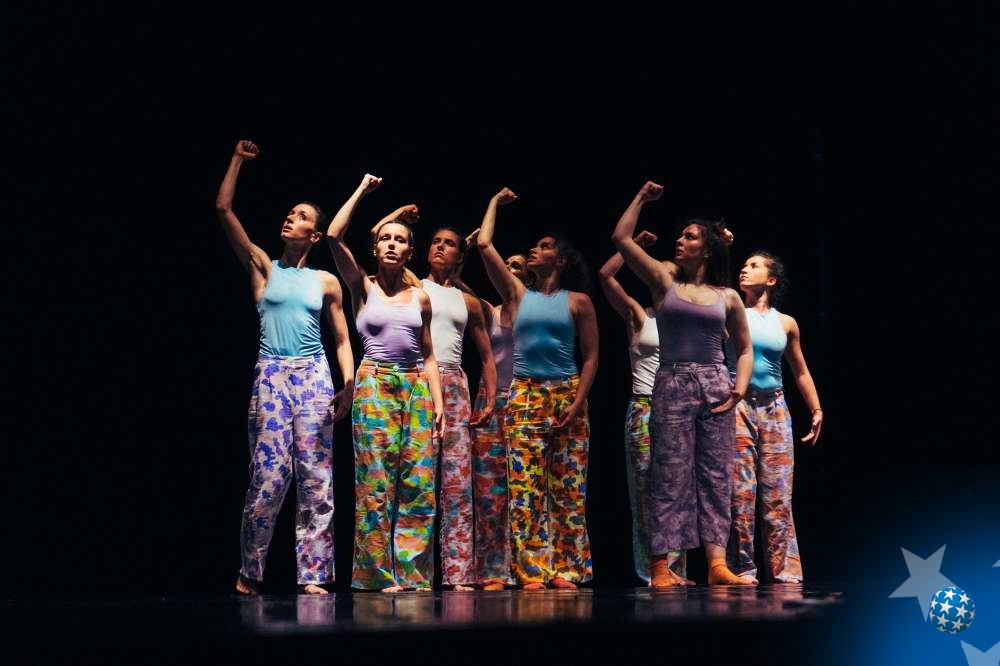The language of movements as an alternative for words…
Decameron 2020 was presented as a work in progress at the 24th Festival of Choreographic Miniatures on YouTube and received significant attention. Meanwhile, the process has been completed and now we get to see the performance on stage. How much has your performance evolved in the meantime, how much has it changed, and has the experience of performing in front of the cameras, without the audience, been helpful in the sense that you can now add to your work yet another level to the plot and to the visual identity?
- Although we didn’t get to perform in front of the audience, the Festival of Choreographic Miniatures meant for Decameron 2020 the end of isolation. Some amazing people got together, they were interested in what we were doing, and felt the need to tell their story through us. The segment we presented at the festival is a mix of choreographies and, back then, the performance had some spoken scenes. Once I realized that people could understand the movement on its own, and only by the fragment they saw on the festival YouTube channel, I excluded the words entirely. I recognized the need to communicate on another level.
What made you choose Boccaccio’s Decameron, and how difficult was it to translate such masterpiece into the language of dance, that is choreography?
- That is exactly how I treated Boccaccio’s Decameron - as a masterpiece. And what makes it a masterpiece is, among other things, its potential to be modern. It served as a platform for our own stories that asked to be told in the language of movement. The book stayed on the shelf, I haven’t read it since high school, but the performance clearly reflects its structure, circumstances, topics, the courage of the characters to speak up about their problems with distance and humour, and their power to use creativity to overcome uncertainty.
You spend a lot of time with the people you cooperate with, because you see each other at your studies, but also in the cultural centre Magacin, where your meeting point is. You cooperate, in less-than-ideal conditions, in order to perfect your dance technique. Could you tell us a bit more about the ensemble? Has the fact that you know each other helped you place more trust into the exploration, and how did you manage to coordinate your obligations and the rehearsals?
- The ensemble of Decameron 2020 consists of the people I met in the Cultural Centre Magacin, and at the Institute for Artistic Dance. Most people don’t do only dance, each of us comes from a different background. We did know each other but the trust developed during this process which required us to share everything to make the performance sincere. And to understand each other in case we don’t feel like sharing anything. Yes, we are different, but we have managed to create a space for understanding. I feel as if before this process I could neither listen, share, nor tell a story in the language of movements, the language I recommend as an alternative for words. And I learned all of it from the Decameron ladies.
Has the isolation caused by the coronavirus contributed to your dedication to the topic of isolation and individual processes of healing? Has it brought you closer to the ensemble or alienated you from them? How did you organize the rehearsals during the pandemic?
- We used the experience of isolation during the coronavirus pandemic and turned it into the inspiration for a story of alienation in various forms of misunderstandings and loss of communication. We kept the process alive despite our obligations, despite the anticipation of the date of the opening, despite illnesses, etc. And we didn’t find it hard. We were eager to perform and that was the only certainty to hang on to in this crazy period.
Each process is, in a way, isolation. This one wasn’t. You see eight of us on stage but a lot more people and stories gathered around Decameron 2020. This performance was being prepared during a period which taught us that a creative process maybe shouldn’t be an isolation, because everything else is. On the contrary - it should be a space and model for establishing links and mutual understanding.
This is the first time your work is included in Bitef Polyphony. What does it mean to you as a young choreographer to participate at Bitef and to which extent can you relate to this year’s slogan “Edge of the Future”?
- I can relate and I am sure that Boccaccio’s protagonists from the plague-tormented 14th century could, too. Yes, this is yet another edge. The worst one - just like all the previous ones were. As a young choreographer, an artist, I am standing on the edge because that’s the best position from which you can see what follows. And that’s my job, that’s the gift, but also obligation that I get from art - to tell the others what I see so that they don’t have to go through it themselves. That’s the exact same thing my colleagues, artists do. Those are some powerful people.
For me, Bitef Polyphony and Bitef Festival mean that I’m not alone on that edge.
And that means a lot.
Also, what I, as a young choreographer, find interesting at the moment is to explore falling. Almost every scene of Decameron 2020 ends in a fall.
But there’s always something to follow.
Thank you for the answers, good luck at the performance and keep creating your dreams on the edge.
“Dance, dance, otherwise we are lost” - Pina Bausch

